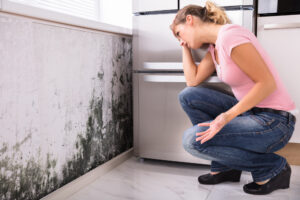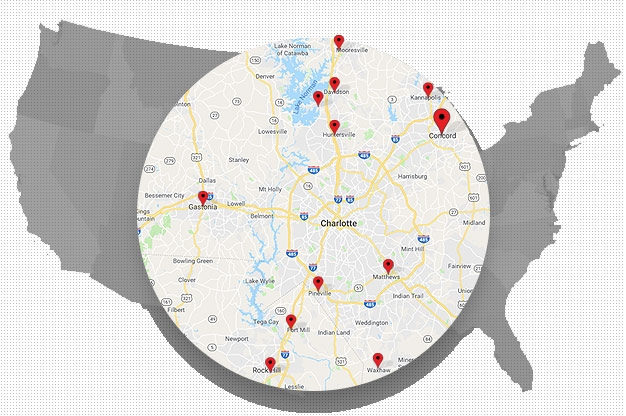Why Water Damage Is Your Home’s Sneakiest Issue

Throughout the multiple months of stay-at-home orders and quarantine, you more than likely saw your house in a way you never saw before.
Stripped from your commute, happy hours, and your kids after school activities, you were better able to scrutinize every corner of your home. You noticed repairs that need addressing, big and small.
You also noticed water damage. You’d never seen it before, but now that you have you’re not sure what to do. Water damage in the home is nothing to take lightly, and you shouldn’t ignore it.
Ignored water damage will sneak up on you and turn into a major problem very quickly. Read on to learn more about it.
Health Hazards
It’s true that water damage isn’t always easy to spot. We’re so often tipped off by a leaking roof or standing water in our basements – yet, our houses are full of dark corners that are hard to see.
Worse yet, it’s all too easy to ignore water damage because there isn’t a noticeable leak. It’s not something you can afford to forget about.
When talking about water damage, the first thing to note is that water inside your home will lead to multiple health hazards. Water damage compromises the health and well-being of you and your family.
Where water comes in, mold grows. Mold causes allergic reactions that will exacerbate already existing health issues like asthma and COPD.
Water damage also attracts pests. Spiders and other bugs love moist areas – cockroaches especially.
Cockroaches and other pests carry many diseases with them. Constant exposure could lead to severe illness.
Structural Damage
Left untreated, water damage takes a chunk out of your wallet. Hard to believe, but even a trickle of water will degrade the structural integrity of your home in severe ways if you let it.
Walls will bubble and crumble. Paint and plaster will chip from the ceiling. Brown water stains will crack and spread.
What’s inside those walls? Your electrical system. You know water and electricity don’t mix.
It’s not just your paint, plaster, and electrical system. Left alone, a trickle of water degrades your bricks and concrete. This type of concrete damage, especially to your home’s foundation, costs thousands to repair.
How to Spot Water Damage
What makes water damage such a sneaky home problem is its ability to hide for years. Basements, closet walls, crawl spaces, and attics are all dark rooms we don’t inspect often.
By the time water damage in these spots rears its head in other rooms in your home, you’re already in trouble.
The best way to stop water damage is to inspect your home for the signs – and yes, where to look for water damage means all the dark corners you ignore.
1. Smell
Does your house smell musty? Do you notice dank odors reminiscent of wet cardboard? An older home might have these smells in the basement or attic without any real problem.
If the musty odors grow prominent, you may have water damage. Take a look in your bathroom around the bathtub. If the caulking around your tub is cracked or peeled, there is water dripping underneath.
2. Cracks
When you’re in your basement, do you see cracks forming in the concrete walls? Or is the floor noticeably damp near the corners?
These are signs of basement water damage. Your basement is the most humid spot in your home. Underground, water finds its way in the smallest cracks or imperfections in your concrete.
3. Dripping Noise
Do you hear a loud dripping noise you can’t place whenever there’s rain? If you live in a cramped neighborhood, it’s easy to blame the noise on something outside like your neighbor’s gutters.
If you hear a dripping noise inside, it’s wise to take a look in the attic. A leaking roof doesn’t always show with dripping water into your bedroom or living room.
4. Spotting
You’ll see this on your ceilings. The spotting from initial water damage looks like a dark stain. If not repaired, this spot indicating damage spreads and degrades your subfloor and wooden beams.
You should take action if you notice any discoloration on your walls and ceilings.
5. Peeling Paint
Water damage doesn’t mean you have a leak, though water leaks do present large issues. Your home humidity levels might be high.
Bathrooms without ventilation are a common room to find this type of damage. Steam from hot showers lingers in the room’s atmosphere and causes damage to the paint, causing it to crack.
Moisture from condensation on exterior facing walls leads to water damage, too. Think of a soda can.
If these walls don’t have proper insulation, the cold from the outside meets the indoor heat. When this happens, water from the atmosphere beads on the walls and will crack the paint and cause mold growth.
Seek Professional Help Immediately
The cost of water damage repair increases the longer you ignore the problem. What could’ve been an easy patch and repair will transform into a much more expensive and complicated problem.
While your house is built to last, the materials will degrade over long periods of water exposure.
When you see the signs of water damage, you have to act fast and get a professional on the phone.
Don’t Let Water Damage Sneak Up on You
Water damage is too easy to miss. Found in the dark corners and rooms of your home, you might not notice it for years.
It’s also too easy to ignore. Leaks aren’t always obvious.
If you notice the signs of damage, seek professional care immediately. Doing so will save your home and your wallet.
Are you dealing with water damage in the Concord, NC area? Sedona Waterproofing Solutions is here to help.
Contact us today for an appointment.
Recent Posts
- How Crawl Space Encapsulation Benefits the Environment – An Expert Guide
- 6 Ways Professionals Keep Your Crawl Space in Top Shape
- Structural Repair Solutions for Crawl Spaces, Basements, and Foundations
- Essential Crawl Space Repair Tips Every Homeowner Should Know
- The Importance of Radon Mitigation: Ensuring a Safe Living Environment for Homeowners
Categories
- Basement Mold
- Basement Waterproof Foundation
- Basement Waterproofing
- Crawl Space Dehumidifier
- Crawl Space Encapsulation Cost
- Crawl Space Repair
- Crawl Space Waterproofing
- Encapsulation
- Foundation Repair
- Foundation Waterproofing
- French Drains
- Leaky Basement
- Mold Remediation
- Mold Removal
- Radon
- Slab Jacking
- Sump Pump
- Uncategorized
- Vapor Barrier
- Water Leak
- Waterproofing
- White Mold
Archives
- June 2024
- May 2024
- March 2024
- January 2024
- June 2023
- May 2023
- April 2023
- March 2023
- February 2023
- January 2023
- December 2022
- November 2022
- October 2022
- September 2022
- August 2022
- July 2022
- June 2022
- May 2022
- March 2022
- February 2022
- January 2022
- December 2021
- November 2021
- October 2021
- September 2021
- August 2021
- July 2021
- June 2021
- May 2021
- April 2021
- March 2021
- February 2021
- January 2021
- December 2020
- November 2020
- October 2020
- September 2020
- August 2020
- July 2020
- June 2020
- May 2020
- April 2020
- March 2020
- February 2020
- January 2020
- December 2019
- November 2019
- October 2019
- September 2019
- August 2019
- July 2019
- June 2019
- May 2019

